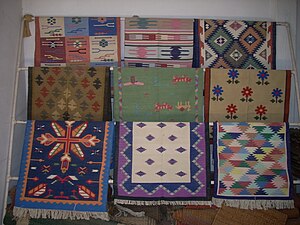Dari (textile)
Darī (Hindi दरी, English durrie , dhurrie ), is the name for a type of simple woven carpet , usually made of cotton or wool , more rarely made of jute , silk or leather , and often a mixture of everything from India , Pakistan and Myanmar ( Burma).
Concept and history
As early as 1590 and 1683, European traders and travelers mention a weave called doriya from India as a trade item . The term is at Hobson-Jobson of Hindustani ḍoriyā "thin striped fabric" or DOR, Dori derived "cord leash". The darī is not - like the carpet - knotted, but woven and therefore has neither a separate back nor a pile like this one. The size of the Darī is limited to smaller formats up to a width of 24 "(61 cm) due to the hand-weaving frame, but was also made (for assembly rooms) in the dimensions 6 × 6 meters. Traditionally, stripes, geometrical ones, dominate the patterns Shapes and rudimentary Islamic motifs, the colors indigo blue and the light tones beige and ivory to white are characteristic. Regionally, from Tibetan-Chinese (dragons, clouds) to heavily colored South Indian or stricter North Indian-Muslim a wide range of traditional With modern Darīs the shape and color design is more free.
Revival after 1947
At home in many areas of India for a long time, the darī used until then as a simple textile for floor coverings, mattress pads or outer packaging (“poor relative of the carpet”) has experienced a renaissance since the division of the subcontinent in 1947 and the associated population shifts; Refugees from Hyderabad (Sindh) brought patterns and techniques with them to Panipat near Delhi , the center of the wool trade at that time and today's metropolis of Darī production. While the lush woolen rug in the Mughal style lost its appreciation, the darī has enjoyed increasing popularity since then, not least because it is inexpensive, transportable, washable and easy to clean, can be laid out on both sides due to its weaving technique and is resistant to silverfish and Insect infestation applies, but also because designers such as Shyam Ahuja , Anand Sagar Khera and his son Madhukar Khera (Darīs since 1966) or Neeru Kumar helped the formerly rustic and non-color-fast fabrics to break through by reviving traditional craftsmanship and modern designs.
The Darī today
The trend is towards Darīs, made from natural materials, of high quality, woven on a handloom. Designer darīs are now considered chic and fetch good prices, even as used goods ( vintage ).
supporting documents
- ↑ "dur-rie \ 'dərē \ n -sa thick cotton cloth or carpet made in India"; Webster's Third New International Dictionary (Merriam-Webster). The English language unabridged . Springfield / Mass. 1961 (ND Cologne 1993), p. 621. - "(small, simply woven) carpet"; Erika Klemm: Dictionary Hindi-German . 4th edition, Langenscheidt, Leipzig / Berlin / Munich a. a. 1997. p. 201; "(Cotton) carpet m, runner m"; Margot Gatzlaff-Hälsig (Ed.): Concise Dictionary Hindi-German . Buske, Hamburg 2002. p. 621. - For the distribution area see Indinan Dhurrie Rugs
- ^ Henry Yule. AC Burnell: Hobson-Jobson. The Anglo-Indian dictionary . Reprint of the 2nd edition, 1902. Wordsworth, Ware 1996, pp. 325 and 706; Verklaringen van termen, verzameld uit de Rijks Geschiedkundige Publicatien betrekking hebben of de Verenigde Oost-Indische Compagnie . Instituut voor Nederlandse Geschiedenis, Den Haag 2000, p. 40.
- ↑ Hobson-Jobson, p. 325, p. a. Gatzlaff-Hälsig: Hindi-German. P. 565.
- ↑ Durries, india durry, carpet, flooring and rugs, panipat durry, jute fiber. In: indiaprofile.com , accessed December 12, 2017.
- ↑ Dhurrie rugs | Indian dhurries | Doris Leslie Blau New York In: dorisleslieblau.com , Retrieved December 12, 2017.
- ↑ Shyam Ahuja In: shyamahuja.com ; Neeru Kumar In: neerukumar.com ; Heritage - Bharat Carpet Manufacturers In: bharatcarpet.com , accessed December 12, 2017.
Web links
- Durries, india durry, carpet, flooring and rugs, panipat durry, jute fiber. In: indiaprofile.com

